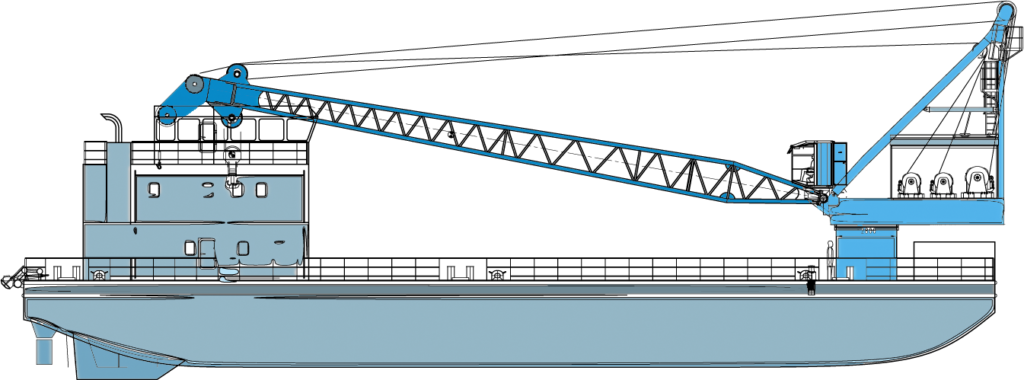CRANES FOR FLOATING BARGES
Based on our expertise and long experience, combined with a new innovative barge design, we are able to supply floating barge cranes according to your requirements. Our main floating crane types are focused to have a high capacity and a long outreach, up to 36 meters.
ISKAR has successfully designed and introduced a wide range of tailor-made crane models.
The benefit of the barge cranes is that they offer flexible solutions for cargo
and bulk material handling in harbors or on rivers, where there are few quays or none at all. Lattice boom type barge cranes can be delivered in hook duty heavy load configuration or 4-rope grab duty configuration.
The main difference between a hook duty crane and a grab duty crane is its ability to dissipate heat. Hook duty – heavy load cranes are lightweight with large counterweights designed for ease of mobilization and stability. Grab duty cranes are designed for stability with oversized components that can withstand the shock loads of starting and reversing a counterweight and payload without overheating.
ISKAR engineers have designed its cranes to move a payload without moving excess weight such as hydraulic arms and cylinders. The excess weight of these components at extended radiuses will result in excessive maintenance costs without contributing to payload capacity.

CRANE CONFIGURATION
The dimensions and specifications of a floating barge crane is highly related to its duty and customers’ requirements. ISKAR offers FBC Models cranes as main specs are given on the table below.
Capacities and dimensions different than the FBC models can be designed and manufactured on request.
HOOK & GRAB DUTY
Single Layer Winches
4-rope grab duty applications require wire rope on one layer of the drum, including the boom hoist wire, to ensure long rope life.
Grab
The grab is equipped with an internal reeving wire that connects to the closing ropes. The two holding ropes attach with chain sections to the top frame of the clam.
Line Speed
In order to achieve high cycle times, hoisting velocity of the full load should be as much as 60 m/min and hoisting down should be in excess of 90 m/min. The engine must be sized to allow hoisting, swing and luff at full speed simultaneously without exceeding 85% of the engine rating.

Slew Bearing
The construction of the upper and the lower must be very stiff, deep and heavy structures that will not flex during high speed duty cycling. Large diameter rings are required to ensure high capacity and large radius for
the swing pinions. Rolling elements must be very large, 2 inch diameter in the case of ball bearings. On larger machines, some makers use a triple roll roller bearing design. The slew bearing must be designed for at least one million cycles under full load.
Hydraulic Systems
Closed loop design is preeminent in duty cycle applications. In closed loop systems, each function has its own pump; pressure is created only when demanded. In open loop machines such as lift cranes and excavators, the pump is continually supplying oil under pressure to a valve manifold that directs oil to various functions. This creates an abundance of heat and results in short life of the pumps. PLM uses Mannesman Rexroth pumps and Motors that are designed for 340 bar, but are running at about 180 bar. Closed loop hydraulics operating at 180 bar to 210 are vital to cooler operating temperatures which achieves longevity.
Control Systems
Acceleration loads are usually ignored in lift crane design. Duty cycle cranes use pilot line control or electronic control. Duty cycle cranes are equipped with dual mode systems. In clamshell or dragline mode, boom angle is
displayed digitally in the operators cab; however, the load is not indicated. Load is controlled by the size and opening of the bucket and sensors built into the winch circuits that prevent hoisting loads which are too heavy.
Boom is controlled by limit switches to prevent working outside the safe range.
Corrosion Protection
ISKAR Cranes are grit blasted after all welding has been completed and are coated immediately with zinc rich epoxy. Two additional epoxy anti-corrosive coats are applied followed by a polyurethane top coat.
Boom and Sheaves
Heavy boom construction with large diameter heel pins and large diameter sheave axles are required for continuous duty cycle applications. Chord sections should be thick and must be designed as compact sections. Chords must also be thick and heavy to withstand years of corrosive service. Sheaves must be sturdily constructed with very wide bore, large diameter and open throat design for heavy side loading.
Automatic Lubrication
Autolube is a standard feature on duty cycle cranes to ensure that all points such as the slew bearing, slewp inion, head sheaves, boom sheaves, and boom trunnions receive grease.
Cabin and Comfort
ISKAR Cranes for barge and ship unloading come equipped with hydraulically raised and extendable cab as standard equipment. This gives the operator clear view over the cargo holds. Standard equipment includes heating, a/c climate control, cd/radio player and comfortable seating.
Multi-Function
ISKAR Barge Cranes can be used as a clamshell or lift crane and designed to be mounted onto ships or barges. They can be also be mounted on gantries or fixed pedestals.
